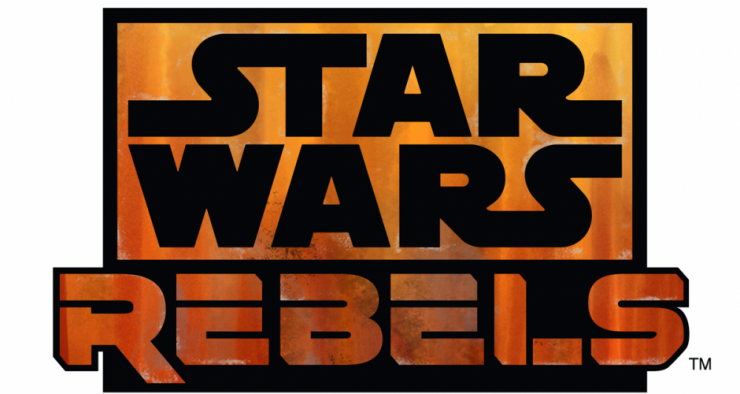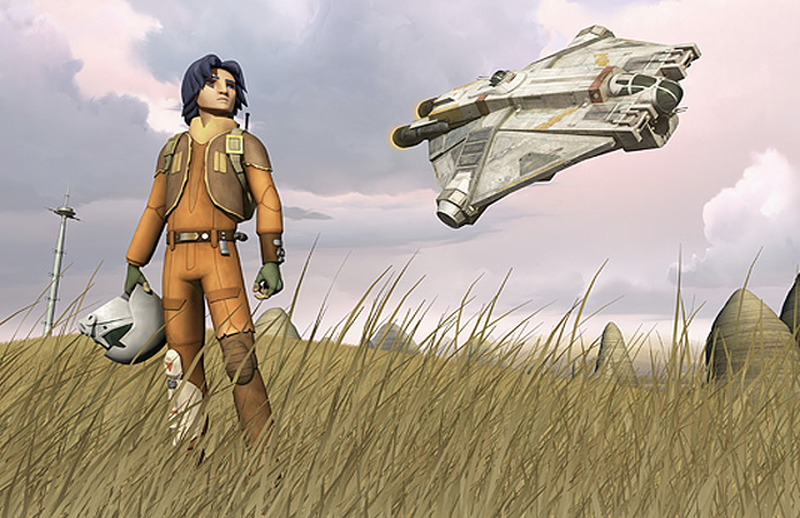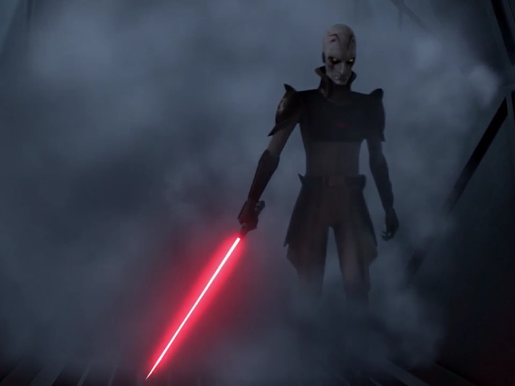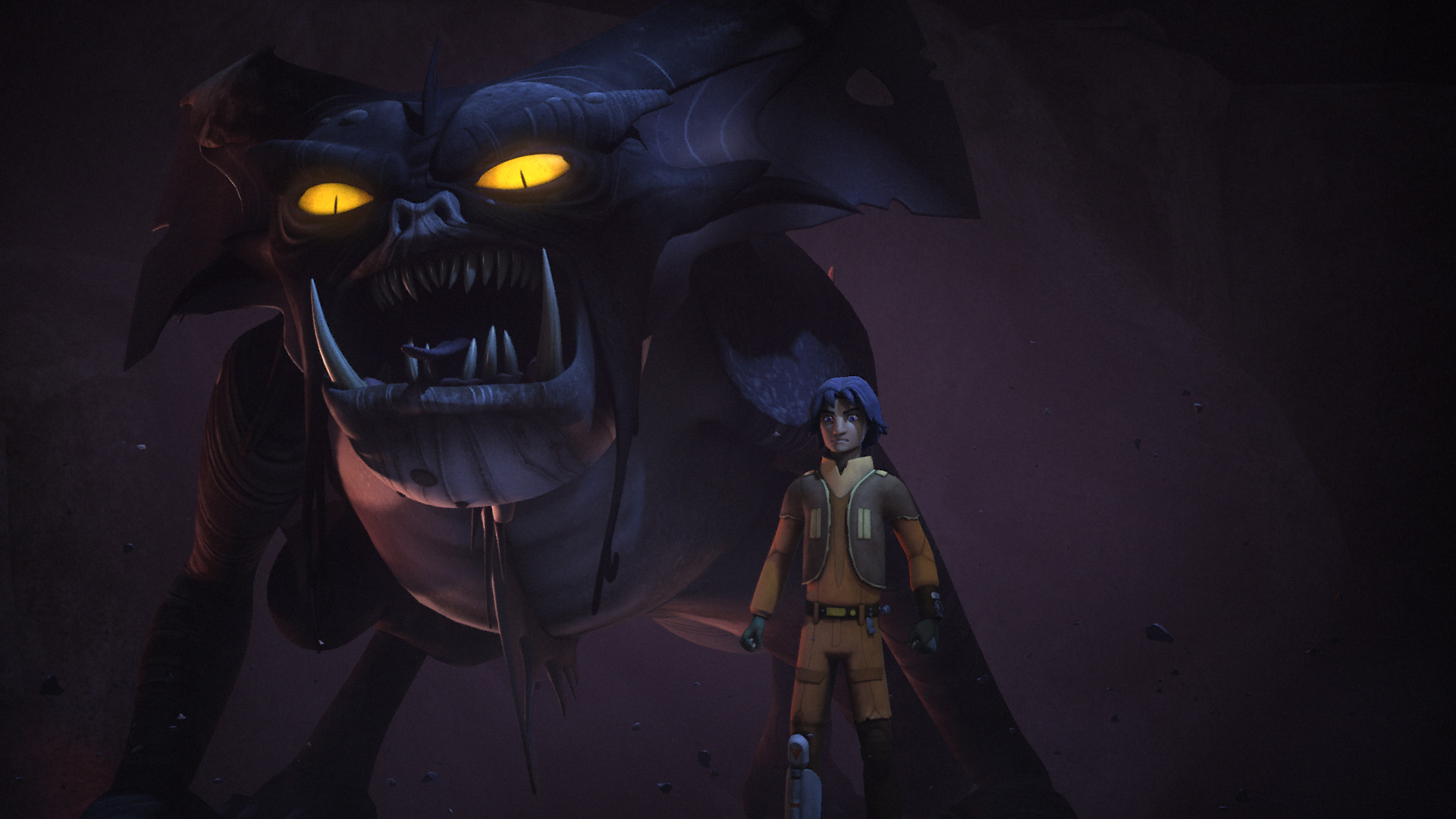Debuting in October of last year on DisneyXD, Star Wars Rebels was the first offering to come out of Disney’s lock, stock, and barrel acquisition of the Star Wars multimedia franchise. Rebels is intriguing in that it’s the first time since those weird Ewok TV movies that a non-novel/comic Star Wars outing has focused largely on original characters. As you’d expect from the title, Rebels centers around a gang of righteous freedom fighters, set five years prior to the events of A New Hope. It also swaps the familiar Millenium Falcon out for the similarly hamburger-shaped Ghost.
Within minutes of the show’s 44-minute pilot, it becomes clear that Rebels really gets Star Wars on a concept level. Essentially a long heist sequence, “Spark of Rebellion” does a great job of introducing the series’ cast while remembering that the original films were, you know, actually fun to watch. There’s a ton of moving pieces here: the crew of the Ghost attempts to steal mysterious freight from an Imperial installation, only for orphan thief Aladdin Ezra to steal from them, kicking off a chase sequence that ends with TIE fighters chasing our heroes through a vast grassy field. It’s a fantastic bit of animated action choreography, and it really sets the tone for the series as a whole.
The original characters developed for Star Wars Rebels are, by and large, pretty cool. In addition to requisite callow youth/Jedi-in-training Ezra Bridger, we’re given former padawan turned captain Kanan Jarrus (voiced by Freddie Prinze Jr.), Mandalorian artist/demolitions expert Sabine, Twi’lek pilot Hera, Lasat muscle Zeb, and surly droid C1-10P, a.k.a. “Chopper.” There’s a pretty obvious attempt to create new characters who are simultaneously original and reminiscent of the characters and concepts we associate with Star Wars: Zeb is based off of an unused Ralph McQuarrie Chewbacca design, Chopper is “R2-D2 but an asshole,” Sabine is a more colorful take on Boba Fett, etc. The downside to this is that the characters fulfill almost interchangeable positions in the plot. If the prequel trilogy suffered from not having a “Han Solo type” character, Rebels might suffer from having too many. The show’s inclusion of two female, distinctly non-damsel in distress leads, Sabine and Hera, is a great shot in the arm for the notoriously boys club-y Star Wars universe.
Ezra and Kanan, as apprentice and master, resemble the pre-existing Jedi partnerships we’ve seen, but with the interesting wrinkle that they’re both the kind of bastardized Jedi that Luke Skywalker was in the original trilogy. Ezra and Kanan are both often more comfortable with a blaster than a lightsaber during the show’s action scenes. While in-story this is because Ezra is untrained and Kanan is attempting to keep a low profile, the larger effect is that we only see either use their abilities during important story moments. In my favorite moment of the season, characters are visibly in awe when Kanan first ignites his lightsaber for battle. Given the show’s down and out pluckiness, It’s fitting that Ezra’s eventual weapon is a combination blaster and lightsaber he salvaged from scrap parts. With the Jedi Order all but extinct, our heroes are two illegitimate keepers of the faith.
The season’s primary antagonist, an unnamed Imperial known as The Inquisitor (Jason Isaacs), is a reflection of this idea. Ostensibly a Sith but never explicitly referred to as such, The Inquisitor’s job is recruiting or culling any force-sensitive individuals the Empire comes across. His introduction in “Rise of the Old Masters” is pitch-perfect in its pure dread.
Like Ezra’s, The Inquisitor’s lightsaber is gimmicky (It spins on a gyroscopic handle). While probably designed in part to make for a cool toy, this is also a signal that The Inquisitor isn’t a Jedi or Sith in any traditional sense. Extra villainous support is provided by ruthless Imperial pointman Agent Kallus (voiced by David Fucking Oyelowo. Really.) and a limitless supply of canon fodder Stormtroopers. Although less flashier than The Inquisitor, Kallus gets some interesting backstory and Oyelowo plays him with restrained menace. There’s a genuinely hilarious moment towards the end of the pilot when an irritated Kallus kills a Stormtrooper by kicking him off a bridge. Rebels seems to have an appreciation for the comic value of Stormtrooper deaths.
Rebels‘ animation suffers from the occasional clunky for-television CG, but redeems itself with detail and texture.Throughout the series, we’re given glimpses of rusted or repurposed Clone Trooper transports as background artifacts, war machines from a conflict our characters have largely forgotten about. There’s an acknowledgment of history here. In an especially striking moment in the episode “Gathering Forces,” a force-controlled giant Fyrnock monster rises up from behind Ezra to visually depict his subconscious use of the dark side. The season’s semi-frequent lightsaber duels are a visual treat, frenetic and suspenseful while never gratuitous.
Over the course of its first season, Star Wars Rebels really impressed me with surprising story beats. When Kanan approaches Ezra to become a Jedi, the series flips the traditional call to action we’ve come to expect: Ezra returns Kanan’s stolen lightsaber to him. In the season finale, “Fire Across The Galaxy,” Kanan exploits the unusual design of The Inquisitor’s blade and disarms him. Taunting Kanan that “There are some things far more frightening than death,” The Inquisitor opts to kill himself. There’s something admirable in Rebels killing off their chief villain in the first season without revealing so much as his name.
The maiden season of Star Wars Rebels delivers thanks to the cocktail of space cowboy slickness and operatic drama that makes “Star Wars” “STAR WARS.” While Rebels is definitely a children’s show, the creators are committed to telling a rich and engaging story first and foremost. There’s plenty of room to grow from here and, given that the show’s cast isn’t beholden to appearing on the big screen, there’s an opportunity to take risks that, say, Marvel’s new Star Wars comics can’t. I hope we’ll find a second season full of surprises.
Read more from our ongoing essay series, The Year of Star Wars!






